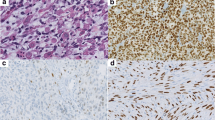Abstract
Rhabdoid glioblastoma is a rare type of glioblastoma characterized by cells resembling rhabdomyoblasts. Several reports have identified its aggressive clinical course and the pathological differences from other primary brain tumors. We report a case of rhabdoid glioblastoma in a 12-year-old boy who presented with headache and harbored a 70-mm solid tumor in the left temporal lobe. The tumor was surgically excised, but early tumor recurrence and leptomeningeal spread developed, and the patient died of the disease 4.9 months after surgery. Histologically, the tumor contained two distinct patterns of glioblastoma and rhabdoid cells with necrosis and hemorrhage. Immunohistochemical analysis revealed that both cells were positive for glial fibrillary acid protein, vimentin, and INI1, which is consistent with the reported diagnosis of rhabdoid glioblastoma. Genetic studies confirmed no loss of the INI1 gene and identified hemizygous deletion of the CDKN2A gene. We review reported cases of rhabdoid glioblastoma and summarize the clinical, radiological, and histological features.




Similar content being viewed by others
References
Louis DN, Ohgaki H, Wiestler OD et al (eds) Tumours of the central nervous system. World Health Organization classification of tumours. IARC, Lyon, pp 25–49, 132–149, 164–172
Wyatt-Ashmead J, Kleinschmidt-DeMasters BK, Hill DA et al (2001) Rhabdoid glioblastoma. Clin Neuropathol 20:248–255
Lath R, Unosson D, Blumbergs P et al (2003) Rhabdoid glioblastoma: a case report. J Clin Neurosci 10:325–328
Fung KM, Perry A, Payner TD et al (2004) Rhabdoid glioblastoma in an adult. Pathology 36:585–587
Kleinschmidt-DeMasters BK, Meltesen L, McGavran L et al (2006) Characterization of glioblastomas in young adults. Brain Pathol 16:273–286
Kleinschmidt-DeMasters BK, Alassiri AH, Birks DK et al (2010) Epithelioid versus rhabdoid glioblastomas are distinguished by monosomy 22 and immunohistochemical expression of INI-1 but not claudin 6. Am J Surg Pathol 34:341–354
Judkins AR, Mauger J, Ht A et al (2004) Immunohistochemical analysis of hSNF5/INI1 in pediatric CNS neoplasms. Am J Surg Pathol 28:644–650
Momota H, Holland EC (2009) Mouse models of CNS embryonal tumors. Brain Tumor Pathol 26:43–50
Motomura K, Natsume A, Kishida Y et al (2010) Benefits of interferon-β and temozolomide combination therapy for newly diagnosed primary glioblastoma with the unmethylated MGMT promoter: a multicenter study. Cancer. doi:10.1002/cncr.25637
Fults D, Brockmeyer D, Tullous MW et al (1992) p53 mutation and loss of heterozygosity on chromosomes 17 and 10 during human astrocytoma progression. Cancer Res 52:674–679
Hartmann C, Meyer J, Balss J et al (2009) Type and frequency of IDH1 and IDH2 mutations are related to astrocytic and oligodendroglial differentiation and age: a study of 1,010 diffuse gliomas. Acta Neuropathol 118:469–474
Kohashi K, Izumi T, Oda Y et al (2009) Infrequent SMARCB1/INI1 gene alteration in epithelioid sarcoma: a useful tool in distinguishing epithelioid sarcoma from malignant rhabdoid tumor. Hum Pathol 40:349–355
Matsumura T, Yamaguchi T, Seki K et al (2008) Advantage of FISH analysis using FKHR probes for an adjunct to diagnosis of rhabdomyosarcomas. Virchows Arch 452:251–258
Rosenblum MK, Erlandson RA, Budzilovich GN (1991) The lipid-rich epithelioid glioblastoma. Am J Surg Pathol 15:925–934
Rodriguez FJ, Scheithauer BW, Giannini C et al (2008) Epithelial and pseudoepithelial differentiation in glioblastoma and gliosarcoma: a comparative morphologic and molecular genetic study. Cancer 113:2779–2789
Perry A, Fuller CE, Judkins AR et al (2005) INI1 expression is retained in composite rhabdoid tumors, including rhabdoid meningiomas. Mod Pathol 18:951–958
Pimentel J, Silva R, Pimentel T (2003) Primary malignant rhabdoid tumors of the central nervous system: considerations about two cases of adulthood presentation. J Neurooncol 61:121–126
Bannykh SI, Perry A, Powell HC et al (2002) Malignant rhabdoid meningioma arising in the setting of preexisting ganglioglioma: a diagnosis supported by fluorescence in situ hybridization. Case report. J Neurosurg 97:1450–1455
Acknowledgments
We thank Takashi Yamanouchi (Department of Neurosurgery, Nagoya University, Japan) for clinical information and Masafumi Ito (Department of Pathology, Japanese Red Cross Nagoya Daiichi Hospital, Japan) and Seiichi Kato (Department of Pathology, Nagoya University, Japan) for pathology expertise.
Author information
Authors and Affiliations
Corresponding author
Rights and permissions
About this article
Cite this article
Momota, H., Iwami, K., Fujii, M. et al. Rhabdoid glioblastoma in a child: case report and literature review. Brain Tumor Pathol 28, 65–70 (2011). https://doi.org/10.1007/s10014-010-0010-4
Received:
Accepted:
Published:
Issue Date:
DOI: https://doi.org/10.1007/s10014-010-0010-4




